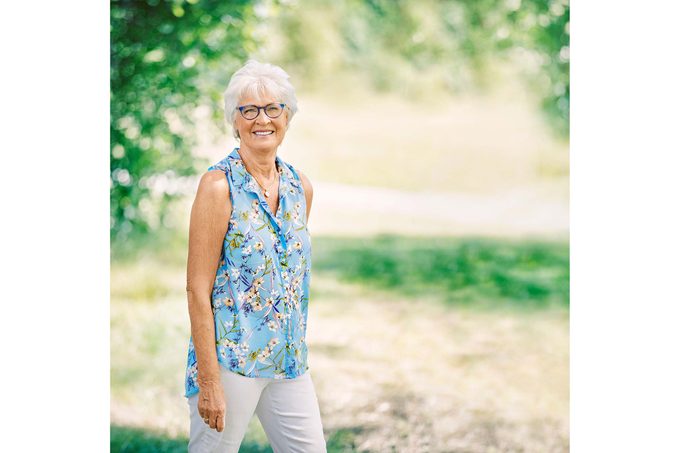This Grandmother Beat Early Breast Cancer With a 20-Minute Treatment
Updated: May 10, 2021
Researchers are exploring less invasive and more targeted treatments for breast cancer that use electric pulses or cryotherapy to kill tumor cells.

On a cold day in January 2011, Margareta Nordell bundled up in her winter coat, hugged her dog goodbye, and went off to have a mammogram, just as she had every 24 months for the past 20 years. As a customer representative for a Stockholm, Sweden-based insurance company (now retired), she wasn’t worried. Never before had a suspicious lump or shadow been found and she assumed this time would be no different. She was wrong. When the X-rays were processed, her doctor pointed to a dot on her right breast. It looked like a speck of dust or something smaller, even.
“But I can’t feel it when I check,” she protested. In truth, there are many signs of breast cancer besides a lump.
“That’s a good thing,” her doctor replied. “If it is cancer, we’ve probably caught it in time, before it grows into something you can feel.”
A biopsy proved it was malignant. All of a sudden Margareta, then 66, an independent mother and grandmother, found herself thrust into a vast club she would much rather not be part of: Women with breast cancer. An estimated one in eight women in the US will develop the disease in their lifetime, according to the American Cancer Society. There will be about 268,600 new cases of invasive breast cancer will be diagnosed in women in the US in 2019.
Margareta didn’t even consider a lumpectomy: Early in the treatment, her doctor asked if she would like to be part of a local trial into a procedure called “preferential radiofrequency ablation,” or PRFA, a technique in which doctors heat up cancer cells to eradicate them. Her age—and the tiny size of the tumor—fitted the trial’s criteria; while there was no guarantee it would work, there would be no cutting into her breast and zero recovery time. She would get a local anesthetic, and the whole thing would last no more than 20 minutes.
Margareta would still undergo minor surgery to remove the dead tissue a few weeks after having the procedure so scientists could examine it; she would also get radiation to ensure the cancer was gone for good; finally, she would get a drug called tamoxifen to prevent the cancer from recurring. But she knew that by going through the demands of the study, she would be helping women diagnosed in the future to potentially avoid the operating table altogether.
“Absolutely, I’ll do it,” she said.
PRFA is one of a number of breast cancer treatments that are being tested on patients. They represent a departure from the standard medical approach: Cut off a whole breast or at least excise part of it, then radiate, then, if the tumor was really aggressive, use chemotherapy, making the overall treatment a trifecta for side effects such as nausea, hair loss and brain fog.
As recently as 50 years ago, scientists thought most tumors were alike and there were few treatment options outside of surgery, radiotherapy, and chemotherapy. As long ago as the 1970s, doctors began to test new treatments such as “precision” drugs like tamoxifen and then trastuzumab, a laboratory-produced antibody treatment better known by its brand name, Herceptin, which can stop cancer cells from growing.
Today, thanks to advances in genetic testing, we know even more about breast cancer. A landmark 2012 study by scientists at the Cancer Research UK’s Cambridge Institute determined that the disease can be divided into ten different sub-groups, each of which may respond to different combinations of drugs, non-invasive treatments, surgery or, in the case of tumors that grow really slowly, potentially no treatment at all. We know about gene mutations, both acquired and inherited, and the possible effects of hormonal levels and smoking on developing cancer. At this stage, there is also clear evidence that alcohol consumption, excess weight, and a lack of exercise increases this risk of developing breast cancer. (Science has actually determined the amount of alcohol that can increase your breast cancer risk.)
“We are continuing to develop methods to detect tumors earlier and to find new telltale markers to help doctors better tailor treatment,” says Dr. Áine McCarthy, the senior science information officer at Cancer Research UK. When physicians know what they’re dealing with—whether it’s an ER-positive tumor (which grows in response to female hormones), for example, or a HER2 positive tumor (one which has large amounts of the human epidermal growth factor receptor 2 protein on the surface of the cancer cells)—will make all the difference in helping doctors develop a treatment plan, Dr. McCarthy says.
In 2016, an international study published in the journal Nature revealed in minute detail the genomes in 560 breast cancers, with researchers sifting through billions of letters of code to find the mutations in each case. While this research—led by the Wellcome Trust Sanger Institute in Cambridge, UK—doesn’t offer a new cure, it represents a giant leap toward treatment that is tailored, not just a specific kind of cancer, but for each patient.
“All cancers are due to mutations that occur in all of us in the DNA of our cells throughout the course of our lifetimes,” says Professor Sir Mike Stratton, director of the Wellcome Trust Sanger Institute in Cambridgeshire, UK. “This study brings us much closer to a complete description of the changes in DNA in breast cancer and thus to a comprehensive understanding of the causes of the disease and the opportunities for new treatments.”
Patient, heal thyself
Your immune system can swoop in to wipe out a virus responsible for your cold, or tackle troublesome cell mutations. Now, researchers like Pamela Ohashi, PhD, director of the tumor immunotherapy program at the Princess Margaret Cancer Centre in Toronto, Ontario, Canada, are trying to direct the immune system to attack cancer cells.
“There are these molecules called ‘checkpoint inhibitors’ which act as stop signals and regulate the immune system,” explains Ohashi. In clinical trials, researchers have tested drugs that block cancer cell stop signals (which allow the tumors to grow unchecked); the results suggest that shutting down the signals allows the body’s T cells, the foot soldiers of the immune system, to find and fight tumors.
“We’re trying to see if the same principle works with breast cancer,” Ohashi says. Patients in clinical trials are getting immune therapy as a last resort after other, proven treatments have not worked.
If the findings are confirmed and immunotherapy becomes reliable, doctors will be able to offer breast cancer patients this option early, potentially allowing them to skip chemotherapy and/or radiation, she says.
“The notion of using the immune system to treat cancer has shown unprecedented success,” Ohashi says. “Combined with other strategies, it has the potential to cure cancer. That could be ten years down the road, but the time has now come to think of it as a reality.”
Cooling things down
The idea is simple: Cool a tumor and the surrounding tissue to the point that the cells within freeze, let the cells burst their cell boundaries or “pop” like a full can of frozen soft drink, and after the malignant ones rupture they are harmlessly reabsorbed into the tissue. An Israeli invention, the IceSense3 machine, which requires a needle to be inserted into the breast tumor, is being tested in patient trials across 20 sites in the U.S. and in one in Japan. The machine is also being tested in Europe and Hong Kong.
Already successful in kidney, liver, and lung cancer treatments, the procedure, which is currently limited to women aged 65 and over with breast tumors that are no more than one and a half centimeters in diameter, takes up to a half-hour, and requires only a local anesthetic.
“You turn the machine on once the needle is placed, and the needle gets cold in about 20 seconds,” says Will Irby, past vice-president at the Memphis-based IceCure Medical Inc., which is marketing the machine in the U.S. “The tumor is frozen from the inside out and you can watch the ice ball being formed with the help of an ultrasound.”
Richard Fine, MD, the director of education and research at the Margaret West Comprehensive Breast Center, a component of the West Cancer Center in Memphis, notes the procedure is non-surgical, and indeed its goal is to replace the surgical treatment of the breast cancer. Additional treatments such as radiation may be recommended on a case-by-case basis. “The patient will still feel a lump for about six months, as the dead cells are being re-absorbed and the changes caused by the cryo-ablation are being resolved,” he says. “After that we do a mammogram where we can see normal breast tissue surrounded by a narrow white outline, which surrounds the zone of treatment.”
For Freehold, New Jersey resident Muriel Smith, having the procedure on February 2 was “a piece of cake”—so easy, in fact, she hopped off the table at the medical center, donned her shirt and went off to a lunch date. Diagnosed on December 17, 2015, she opted for cryo-ablation over surgery because the latter required so much more effort and someone would have had to pick her up afterwards.
“At my age, I’m not really crazy about going under anesthesia,” says the 79 year-old. “I was able to watch everything on the screen. Forty-seven days after the diagnosis, I was free of cancer.” Muriel has to have a mammogram each year for the next five years.
Heating things up
For PRFA, the procedure that Margareta Nordell had, the physician first carefully guides a needle into the tumor with the help of an ultrasound machine and then secures it in place using mechanical micropulses. Following that, cancer cells trying to escape through the tumor’s blood vessels are quickly killed off by the electric pulses in a process called anti-seeding.
Once the doctor positions the needles correctly, the doctor sends an electric current through them and the breast tissue. This triggers mechanical friction that quickly heats the cells up and kills or damages them—depending on the temperature. If the cells can’t grow, they can’t do damage, says Hans Wiksell, a professor emeritus at Stockholm’s Karolinska Institutet who is also the lead scientist on the project and built the PRFA machine. The electrode-needle brings the central body of the tumor to 70 degrees C, which quickly kills all the cells within, while the temperature in the zone immediately outside of the tumor is ideally 43 degrees, where non-cancerous cells can repair the damage but cancerous ones will not.
“The wonderful thing is that the precision and control involved creating a completely different mechanism to treat breast cancer,” Wiksell says. “You can get cancer from chemotherapy and radiation. Nuclear bombs can cause cancer but heat can’t.”
The trial has tested the procedure on 18 older patients, including Margareta, with tumors that are no more than two centimeters in-depth. The trial is limited because older patients tend to have tumors that aren’t as aggressive and fast-spreading as those in younger ones.

As for Margareta, at first she was a bit startled by all the people, computers and other machines in the operating room. Then she closed her eyes and didn’t feel anything at all; barely 20 minutes later, it was all over.
When she was deemed cancer-free for five years, she said: “I’m very lucky and grateful that I could be in this trial. I can be there for my daughter, for my three grandchildren and for Jackie, my Jack Russell terrier. I can keep on living.”